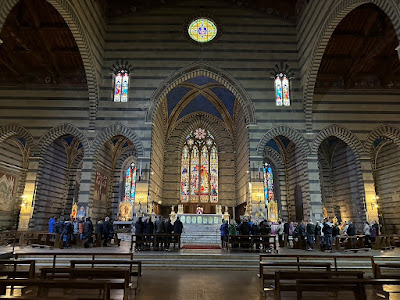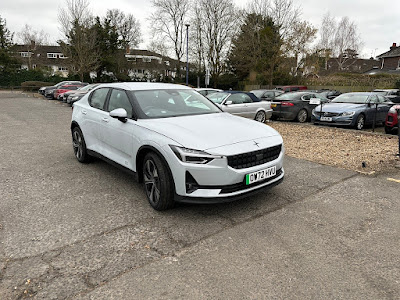In February I had traveled from the UK to Amsterdam to visit the RIjksmuseum and the Vermeer exhibit (see previous post). While in Amsterdam I decided I would go further south, somewhere warmer, Tuscany perhaps. I searched around for a sleeper train that would take me most of the way south and I found one from Amsterdam to Innsbruck. From there I could get another train south from Innsbruck to Florence. Or at least I thought I had found a sleeper from Amsterdam.
After I had finished my visit to the Rijksmuseum I was checking my train ticket and found that I had purchased a ticket from Amstetten to Innsbruck instead of from Amsterdam. That was a surprise and a lesson learned that when buying tickets on my iPhone I need to wear reading glasses and pay close attention. What to do - the Amsterdam to Innsbruck sleeper was now full and I didn’t want to sit upright in a seat all night. I checked flights and I did find one very cheap, 120 Euros, from Amsterdam to Innsbruck so I bought a ticket and immediately headed out for the airport. It was lucky that I checked my original ticket so early otherwise I would have been in a pickle if I had left it until later in the evening.
The flight was uneventful and I arrived in Innsbruck around 6:00 in the evening. The pilot executed perfectly the landing in what must be a tight valley for a 737 jet. The cheap, efficient, and timely bus from the airport to the train station was a pleasant introduction to Austria. The short walk from the station to my hotel, the Sailer Hotel, was also easy.
 |
| Innsbruck at night |
I checked in and then went out for a walk around the city. It looked very clean and tidy compared to London and Amsterdam and even though there was snow on the surrounding mountains it wasn’t too cold.
I had an excellent meal at the hotel’s restaurant - an old styled Austrian Gasthaus. I had a veal snitzel with potatoes and a very fine Austrian beer.
 |
| The River Inn in Innsbruck |
The next morning I awoke early and explored the city some more. There were some lovely buildings in the old section of town and the River Inn was flowing strong. Everything was so neat and tidy and clean. A real pleasure to explore. I really liked the old emblems and signs outside the old shops indicating what type of business they are. Just outside the town is the ski jump slope that was used in the 1976 Winter Olympics. It looks scarily steep.
 |
| The Old City, Innsbruck |
 |
| The Ski Jump, Innsbruck |
 |
| TrenItalia's beautiful high speed train |
Figline Valdarno is not a particularly beautiful spot but I had found a nice hotel there at a really good price. I later learned why it was so cheap - the swimming pool and spa center were undergoing renovation and were closed - I needed neither.
Later that evening I dined in a small restaurant in the square of Figline Valdarno. Pizza, salad and beer - you can’t go wrong - though the only beer available was Sardinian and not quite my favorite.
 |
| The Duomo and Tower, Pisa |
The next day I went to Pisa. The train system is very good in Italy and it was a short hop back to Florence and then another train west to Pisa. The trains are frequent and reasonably clean and they are cheap. A great efficient and eco-friendly way of moving people.
In Pisa there is not a lot to see other than the Tower and the Duomo and the associated buildings. It is a short walk through the town over the Arno river to the tower. Of course on the way there are lots fine buildings and statues, anyone of which would be of historic significance back in the US but here is Italy there are so many such buildings that one becomes immune to their age and beauty. At first sight, the Tower looked like a normal non-leaning tower but as you walked around to one side, the lean becomes quite noticeable and you are amazed at how it still stands. It is a beautiful structure. You can buy a ticket and stand in line to climb to the top but I didn’t feel like dealing with the crowds to do that. I just observed from the ground level.
 |
| The Tower really does Lean, Pisa |
Next to the tower is the Duomo. A magnificent huge church built of the same white marble as the tower. It is quite an awesome sight. How they built such amazingly beutiful large structures I can hardly imagine. It must have taken many years to complete.
 |
| The Babtistry, Pisa |
There is a smaller but no less impressive building adjacent to the Duomo. This is the Babtistry. The Duomo, Tower and Babtistry make for a wonderful;ly spectacular sight. Of course this leads to the area being thronged with tourists. They are everywhere and they all want to take those clever pictures where they appear to be holding up the tower. Sometimes to comical effect.
 |
| Interior of Duomo, Pisa |
 |
| Pisani's Pulpit, Duomo, Pisa |
 |
| Drop a coin in the slot and light a candle |
In a step towards modernity, the church had a array of electric bulb candles in front of certain chapels. You could deposit a coin in a slot and one of the candles would become lit. Presumably that sends your prayer to heaven just as lighting a wax candle was supposed to do. While it is all totally implausible I do much prefer the old way with the wax candles.
 |
| Chiesa di Santo Maria della Spina |
Walking back towards the station there was a beautiful little church sitting by the side of the River Arno. The Chiesa di Santo Maria della Spina. Very nice.
 |
| Keith Haring's Tuttomundi mural |
The return train ride took me through Lucca back to Firenze where i changed for Figline Valdarno.
The next day I visited Siena, again by train. This required going into Firenze and then taking a train out to Siena. Siena sits on top of a hill and the train station is at the bottom of the hill. There are a series of 10 escalators that take you from the station level up to the top of the hill and the old town.
 |
| Il Campo, Siena |
There are a few well traveled routes by tourists through the narrow streets of the old town to the major sights. It was a grey day with occasional drizzle but nothing bad enough to interrupt a casual walk down the old city streets. The first major sight was the main square, Il Campo, a magnificent large sloping area down to the City Hall and the Tower.
 |
| Fonte Gaia, Siena |
Just below the entry on the uphill side of Il Campo is the Fonte Gaia, the Fountain of Joy. This is a beautiful pool that once provided water to all of Siena’s residents. The marble carvings are apparently copies and the originals have been removed to a local church, Santa Maria della Scala.
 |
| The Duomo, Siena |
Next stop was the Piazza del Duoma. The Duomo of Siena takes beauty and splendour to a whole different level. Pisa’s Duomo was a but the exterior of Siena’s is just outstanding - what a treasure. The interior is incredible too. I have seen many fine churches around the world but I think this one is the best.
 |
| Interior of the Duomo, Siena |
 |
| Ceiling of the small library in the Duomo |
The plans were for a larger even more remarkable church to be built but funds ran short. I can’t imagine anything more spectacular than the current one. What grand dreams and designs these people had.
 |
| Interior of Basilica di San Francisco |
The next stop was at the Piazza San Francisco. Here there was a more modest church. A rather plain exterior and much simpler interior. A service was going on with a very small congregation.
 |
| The Giraffe Contrada |
The neighborhoods in the old city are divided into different sections or contrade, each is identified by a crest or emblem containing an animal of some sort. These are shown on walls and street corners around the town. I only saw a few - the Giraffe, the Owl and the Caterpillar. Twice a year there is a wild horse race around the Campo in Siena with riders from each contrada competing against each other.
 |
| Escalators up and down the hill, Siena |
After a late lunch it was a pleasant walk back through the old town and out into the new one and then down the 10 escalators to the station level. Two trains took me back to Figline Valdarno via Firenze.
The next day, Sunday, my last in Tuscany, was going to be spent seeing the sights of Firenze. However the weather did not cooperate. It was raining, it was raining quite hard and it was not pleasant to walk around. There were lengthy coffee and lunch stops in the town and little sightseeing. Being Sunday, the Duomo was closed to tourists but you could attend Mass, which I did. It provided a nice reflective time to absorb the grandeur of the Duomo, the language of the Catholic Mass, and at the same time escape the rain.
 |
| Rainy day in Florence |
The Firenze complex of Duomo, Baptistry, and Campanile are wonderful to behold but on such a wet day it made it a little less pleasant. It did keep the crowds down however. I imagine it must be mobbed with tourists on a sunny day.
The other sights like the Uffizi Gallery, the Ponte Vecchio, etc were sadly missed in favor of warm and dry restaurant and coffee shop interiors.
Monday morning I left the hotel early and caught the train to Florence and then the tram to the airport. The day was clear and sunny but there had been snow in the hills overnight. Florence airport is pleasantly small and it was an easy flight down to Rome and then a connection on to Heathrow.
 |
| the rental Polestar |
Finally another piece of luck, at the Hertz rental facility, they gave me a serious upgrade - from a mini car the Hyundai I10 to a nice all electric sedan - a Polestar. This was a beautiful car to drive, once you got used to the single pedal driving. One of these days we will all drive something like that.

























